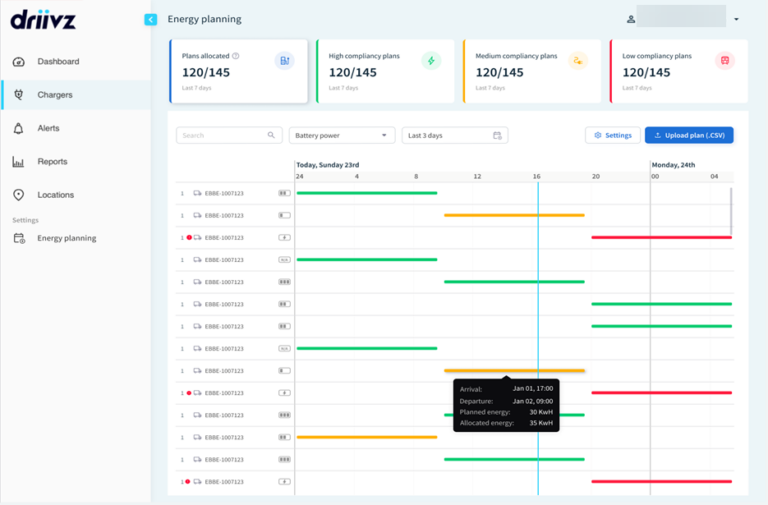Fleet electrification is taking off and is one of the primary drivers of EV adoption. Electric Light Commercial Vehicle (LCV) sales nearly doubled in 2022, and some studies are showing that more than three-quarters of fleet managers are planning for their fleets to be fully electric by 2030. It shouldn’t come as any surprise because fleet electrification presents many benefits. Electric vehicles are cheaper to maintain and cheaper to charge (compared to refueling), which leads to lower TCO. Electrification also helps companies meet sustainability goals by complying with zero-emissions regulations while the company’s brand reputation gets a boost for positive environmental impact. Not to mention the billions of dollars and euros that governments are offering as incentives to help companies in the electrification journey.
But electrification also presents some new challenges for fleet operators. Consider this scenario.
A company has a fleet of electric LCVs (vans), which may be in and out of the depot several times a day according to their delivery schedule. Each van may need to be charged before it goes out on its next route, but the company does not always have enough chargers available on-site to charge all the vans that need it. How does the fleet manager decide which van to charge first, and for how long?
Driivz Insite Energy Planning charges the right EVs so all EVs can get charged
Prioritizing vans manually for charging is doable in a small family business that has just a few vans. A local branch of a nationwide delivery organization that has dozens of vans, several type 2 chargers on site, and one ultrafast DC charger for cases when a “quick fix” is urgently needed (unexpected eventualities do happen in fleets) is a different story altogether. Without energy management, just connecting vans to chargers as they come into the depot will very quickly blow a fuse somewhere. Fleet depots don’t usually have the electrical capacity to charge several vans at once. And prioritizing vans for charging is error-prone and will end up causing delays which may affect the company’s reputation and ultimately, the bottom line. Driivz Insite manages both those issues.
Using peak shaving, Driivz’s SmartChain™ Energy Management ensures that the energy allocated to EV charging does not exceed the site’s capacity. And then, with real-time dynamic load balancing, Insite distributes the available energy between all the EVs actively charging. But how much of that available energy does each EV get?

This is where the planning comes in because the fleet manager can upload a vehicle’s schedule ahead of time. Driivz Insite’s Energy Planning runs an algorithm that considers a fleet’s business needs, and prioritizes an EV for charging according to:
- When it’s expected to arrive at the depot
- When it needs to leave for its next route
- How much energy the EV needs to complete its next route
As chargers are allocated to the different EVs, Insite also registers a reservation for the charger to make sure another driver doesn’t “cut in.”
Here’s a typical energy plan:

For each vehicle in the plan, the lines indicate when a charger has been reserved. The color indicates the extent of compliance with the request for energy that the fleet manager has uploaded. To remain within the site’s electrical capacity, not all vehicles are likely to get all the energy they request right away. The Energy Planning algorithm ensures that the energy available for charging is distributed to the EVs in an optimal manner. For example, a vehicle that only has an hour to charge before its next route may get more energy allocated than a vehicle that has three hours to charge. The color coding reflects compliance of the calculated energy plan in relation to the energy requested:

A fleet manager can set up an energy plan as far in advance as wanted as long as the EVs schedule is known. And to adjust for any surprises on the ground, an energy planning schedule can be updated and the algorithm recalculates and reallocates energy according to the new requirements.
Planning pays off
For most things in life, if you have a plan, you’re more likely to get a better outcome. Energy planning is no different.
Streamline fleet operations around EV charging
EV charging need not be a burden on the fleet manager. Insite’s energy planning optimizes and prioritizes on-site EV charging according to the fleet’s business needs ensuring that EVs always leave the depot with enough charge to complete the route to the greatest extent possible.
Support fleet electrification
With energy for on-site EV charging being managed and optimized, more EVs can be charged simultaneously using existing site capacity – up to six times as many EVs. This means that a fleet can ramp up its electrification efforts and get more EVs on board.
Reduce TCO
With EV charging optimized by energy planning, fleet EVs will be less likely to need a boost at public charging stations. Since public charging is more expensive than charging at the depot, the fleet’s overall EV charging expenses will be lower. Reduced public charging also has an added bonus in that there will be fewer delays while an EV is on its route. And since energy management means the fleet operator can charge more EVs using without expensive upgrades of the electrical infrastructure, there’s another significant cost saving. And remember those expensive ultra-fast chargers that a fleet manager may want to install for those times when an EV needs a quick on-site boost? With optimized energy planning, there will be less of a need for those if at all. There’s another reduction in costs.
Conclusion
Managing enterprise fleets is complex, and the ongoing need for electrification is adding another degree of complexity. Two pillars of effective fleet management are operational efficiency and reduction in costs, and a whole industry has been built around helping fleets reach those goals. Those same pillars also apply to electrification, and they will become even more important as fleets become fully electric. Fortunately, platforms like Driivz Insite with smart energy management that enables energy planning are there to help keep those pillars standing as the world’s transportation in general, and fleets in particular go electric.




